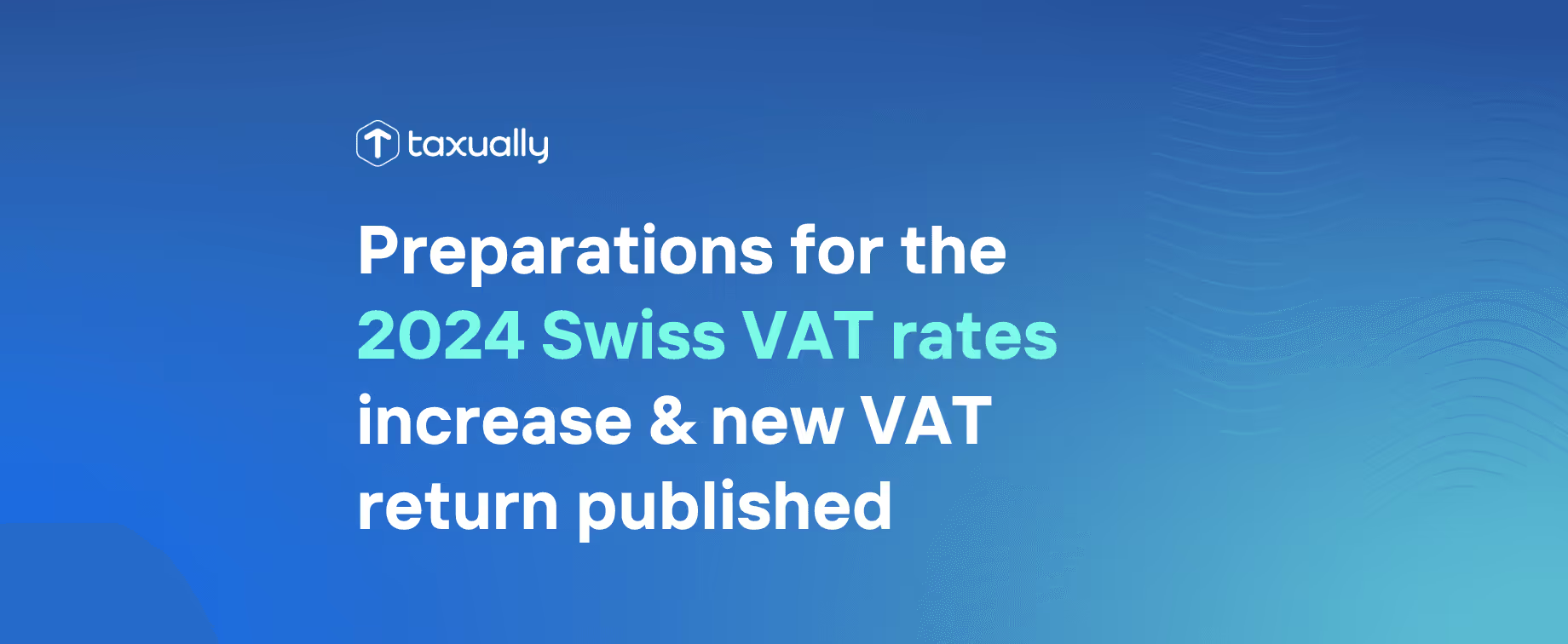Key takeaways
- From January 1, 2024, Switzerland’s VAT rates will increase to 8.1% (standard), 2.6% (reduced), and 3.8% (accommodation).
- The date of supply determines which rate applies — transactions completed before December 31, 2023, use the old rates, while those completed after use the new ones.
- Businesses should update VAT codes, invoices, and contracts to reflect the new rates and ensure compliance with Switzerland’s 2024 VAT rules.
Effective from January 1, 2024, the following revised VAT rates will be applicable in Switzerland, including the Municipality of Liechtenstein:
- New standard rate: 8.1% (an increase from 7.7%)
- New reduced rate: 2.6% (an increase from 2.5%)
- New accommodation rate: 3.8% (an increase from 3.7%)
The new rules on increasing the Swiss VAT rates were adopted by a vote of the general public at the end of 2022 and were formally announced by the Swiss Federal Tax Administration earlier in 2023.
In preparation for these changes, the Swiss Tax Authorities have recently released an updated version of the periodic VAT return form. The modification is designed solely to accommodate the new VAT rates.
The revised VAT return form will feature distinct sections where transactions at the current rates (applicable until December 31, 2023) and the new Swiss VAT rates can be reported separately.
The updated VAT return will be used from July 1, 2023. This allows businesses to adjust their reporting practices in advance and accurately reflect transactions based on the respective VAT rates.
In addition, the Swiss Tax Authorities have already released official guidelines on the transitional rules related to the changes, covering the application of the new VAT rates, partial payments, prepayments, continuous supplies, etc.

As a general rule, determining the application of current and new Swiss VAT rates relies on the date or period of the supply, rather than the issuance of an invoice or payment. Consequently, supplies fully rendered by December 31, 2023, will be subject to the currently applicable rates, while supplies rendered from January 1, 2024, onwards will be subject to the new Switzerland VAT rates.
In cases where an invoice covers supplies that take place in both 2023 and 2024, the date or period as well as the corresponding amounts for each period should be clearly stated and segregated based on the applicable rates. Failure to allocate this information on the invoice will result in all supplies being subject to the new Swiss VAT rates.
For partial payments, invoices, and advanced payments, those pertaining to supplies completed before December 31, 2023, should be invoiced using the current Switzerland VAT rates. Similarly, partial payments for supplies rendered from January 1, 2024, onwards must be invoiced using the new VAT rates. Notably, the Q3 2023 VAT return form will already accommodate the new rates.
In the case of periodic or continuous supplies spanning both the current and new Swiss VAT rate periods, the pro rata temporis principle must be applied to allocate and split the supplies accordingly. For instance, a 3-year maintenance contract covering 2023, 2024, and 2025 should have the portion relating to 2024 and 2025 invoiced with the new rates.
Returns and cancellations of supplies are subject to the VAT rate applicable at the time of the initial supply. Considering the above, if your business operates in Switzerland it’s recommended that you:
- Determine additional tax codes to manage supplies subject to the current VAT rates and those subject to the new rates.
- Review inbound and outbound transactions within the organization that may be affected by the Swiss VAT rate change, such as acquisition tax, leasing and rental contracts, and commission arrangements.
- Review compliance guidelines for the VAT compliance process, aligning it with the new VAT return and rates (available from Q3 2023).
- Review invoice templates, contracts, and other relevant documents to reflect the new rates from January 1, 2024, paying attention to prepayments, continuous supplies, etc.
By following these guidelines, businesses should be able to assess the impacts of the upcoming Swiss VAT rate changes on their organization and take necessary actions accordingly.
Frequently asked questions
New Year's Day - 1/1/2024Memorial Day - 5/27/20244th of July - 7/4/2024Labor Day - 9/2/2024Thanksgiving Day - 11/28/2024Day after Thanksgiving - 11/29/2024Christmas Eve - 12/24/2024Christmas Day - 12/25/2024
What are the new Swiss VAT rates for 2024?
From January 1, 2024, Switzerland’s VAT rates will increase as follows: the standard rate rises to 8.1%, the reduced rate to 2.6%, and the accommodation rate to 3.8%. These updates apply to all businesses operating in Switzerland and the Municipality of Liechtenstein.
When do the new Switzerland VAT rates apply?
The new VAT rates apply based on the date or period of supply. Transactions completed by December 31, 2023, remain under the old rates, while those supplied on or after January 1, 2024, must use the new Swiss VAT rates.
How should businesses prepare for the Swiss VAT rate change?
Businesses should update their VAT reporting systems, invoice templates, and contracts to reflect the new rates. They should also review transactions that span 2023 and 2024 to ensure correct VAT allocation and avoid overcharging or underreporting.



















